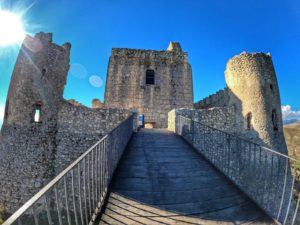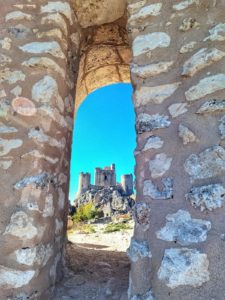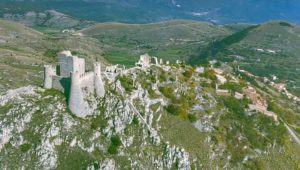 Rocca Calascio
Rocca Calascio![]() is the only fraction of the Abruzzese municipality of Calascio
is the only fraction of the Abruzzese municipality of Calascio![]() , in the province of L’Aquila
, in the province of L’Aquila![]() , and owes its fame in particular to the splendid medieval village that stretches along the south-western slope, and to several ancient buildings that testify to the extraordinary scenic and cultural richness of this marvellous village.
, and owes its fame in particular to the splendid medieval village that stretches along the south-western slope, and to several ancient buildings that testify to the extraordinary scenic and cultural richness of this marvellous village.
The history of Rocca Calascio has very ancient roots, and over the years many archaeological finds, mainly from the Bronze Age, have accumulated, suggesting that this area has been inhabited since prehistoric times.
If you love castles and historical monuments, nature and medieval villages, Rocca Calascio is a must-see. There are many marvels to be admired in Rocca Calascio, but the one that stands out the most is undoubtedly the Castle of Rocca Calascio, located within the Gran Sasso National Park, erected at an altitude of 1450 metres and which is, in fact, among the most elevated ancient castles in Italy and Europe.
 It is a monument of inestimable beauty, one of the most enchanting and representative fortifications in central Italy. The construction is made of square white stone blocks typical of the Abruzzo region, and is characterised by a central keep surrounded on either side by an extensive wall and four towers. It dominates the entire Tirino Valley area, and offers one of the most striking views of the entire Abruzzi region. Such is its magnificence and original architectural peculiarity that it is often cited by many Italian sources, but also by various external sources including National Geographic, as one of the most beautiful castles in the world.
It is a monument of inestimable beauty, one of the most enchanting and representative fortifications in central Italy. The construction is made of square white stone blocks typical of the Abruzzo region, and is characterised by a central keep surrounded on either side by an extensive wall and four towers. It dominates the entire Tirino Valley area, and offers one of the most striking views of the entire Abruzzi region. Such is its magnificence and original architectural peculiarity that it is often cited by many Italian sources, but also by various external sources including National Geographic, as one of the most beautiful castles in the world.
It was probably Ruggero d’Altavilla who endorsed its construction, around 1140, and it was probably for purely military and defensive purposes, given its elevated location and strategic positioning. The beauty of these poignant and picturesque places has captured the interest of the film world on more than one occasion, the most important examples being Lady Hawke in 1985 and The Name of the Rose in 1986.
 Not far from the fortress, along the path leading to the castle, is the Church of Santa Maria della Pietà
Not far from the fortress, along the path leading to the castle, is the Church of Santa Maria della Pietà![]() , a small ancient building set in a spectacular landscape dating back to 1569. According to an old legend, this church was built to commemorate the victory of the local population against a band of dangerous brigands. It is characterised by a peculiar structure with an octagonal base, with each side boasting an extension of about five metres. The predominant style of the exterior façades is Baroque, while the interior is structured as a single hall. Above the masonry altar is a painting of Our Lady of Pity, to whom the entire building is dedicated.
, a small ancient building set in a spectacular landscape dating back to 1569. According to an old legend, this church was built to commemorate the victory of the local population against a band of dangerous brigands. It is characterised by a peculiar structure with an octagonal base, with each side boasting an extension of about five metres. The predominant style of the exterior façades is Baroque, while the interior is structured as a single hall. Above the masonry altar is a painting of Our Lady of Pity, to whom the entire building is dedicated.
Next to the mediaeval village is the Chapel of St Francis, a very small building that is only 36 square metres in size, but which. Inside it contains 16th-century frescoes, restored during the 1900s, and on the altar there is a representation of St Francis. In the past, next to the chapel there was a small accommodation facility for travellers and the poor, and a Monte di Pietà run directly by the Franciscans, which offered loans at favourable rates, much cheaper than those offered by usurers.
 As for overnight stays, Rocca Calascio is home to several hotels operating in restored ancient buildings, for a truly immersive experience in what is one of the most important historical and medieval centres in Italy. However, it is also possible to stay overnight outside the fortress, taking advantage of the various hotels in the municipality of Calascio or in neighbouring towns, such as the municipality of Santo Stefano
As for overnight stays, Rocca Calascio is home to several hotels operating in restored ancient buildings, for a truly immersive experience in what is one of the most important historical and medieval centres in Italy. However, it is also possible to stay overnight outside the fortress, taking advantage of the various hotels in the municipality of Calascio or in neighbouring towns, such as the municipality of Santo Stefano![]() or that of Castel Monte
or that of Castel Monte![]() .
.
Then there are the gastronomic traditions, one of the main peculiarities of the Abruzzo region. Particularly renowned in this area of Abruzzo are the typical lentil soups, which make the most of the indigenous varieties typical of this area, the sheep arrosticini, one of the most renowned gastronomic traditions of Abruzzo, and the charcoal cornetti, one of the most original and particular culinary offerings of the entire region.
